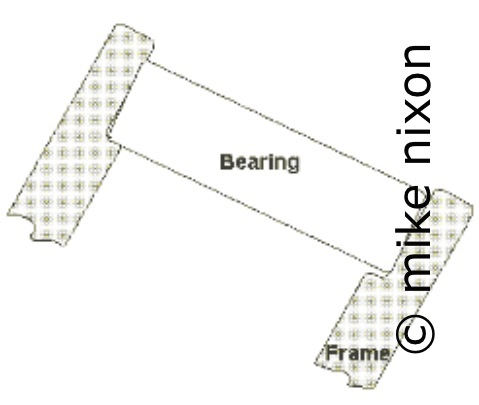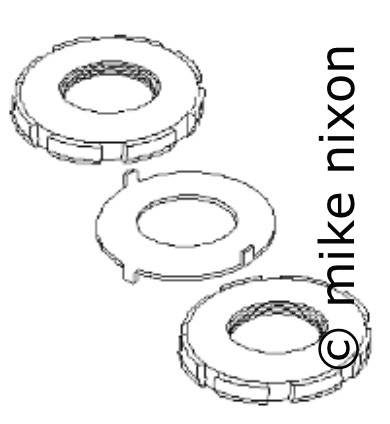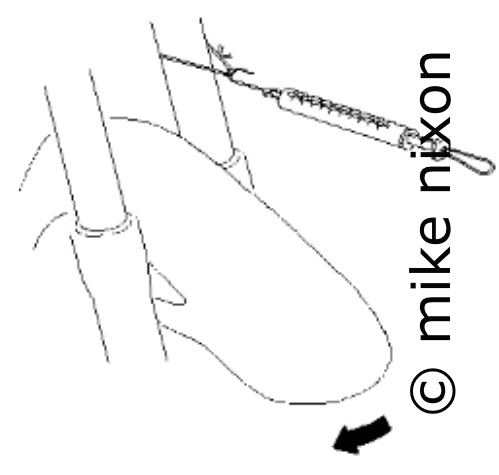  ® ®
|
Shucking the Shakes Revised |
|
Sooner or later, all the larger late model Hondas develop a problem with the steering bearings that results in a head shake when decelerating rapidly from 50 mph and less. For want of a better term, we'll call it a "deceleration wobble."
Many things can cause weaves and wobbles, whether on acceleration or deceleration -- tire wear is especially critical. But decel wobbles have their own special causes, and if the front tire isn't excessively worn or the wheel badly out of balance, the cause is almost always the steering bearings. But we're not talking looseness. The fact is, steering bearing races actually shift in their recesses and become out of square with the steering stem, and out of parallel with each other. And this is thd usual cause of the decel wobble.
The resulting non-parallelness sets up torque forces in the steering which manifest themselves as attempts by the fork to correct itself, with the result: shimmy, shimmy. Again, the problem isn't looseness. Mere tightening often fails to correct the problem.
The following procedure is one circulated by American Honda's District Service Reps back in the day and actually published in Honda Service Letter #126, a document explaining the need to fully seat replacement bearings. Though the technique originated for replacement bearings, it is valid for in-service steering bearings as well. Three tools are needed: a torque wrench, the special factory steering bearing nut socket (Honda 07916-3710100), and a good quality tubular 0-10 lb. spring scale. A floor jack or something similar to jack the front of the motorcycle off the floor will be handy, too.
Follow your manual's instructions for removing the top triple clamp (Honda calls this a "bridge"), so that the pair of special castlelated nuts becomes accessible. The upper one is just a locknut. Remove it and set it aside, along with the special washer. Jack the front end up off the floor, and feel the bearings as you turn the bars each side from center. If the bearings are notchy or the front end has a self-centering action, the bearings need to be replaced, no second-guessing here. After replacing them if necessary, continue. Get the front end off the floor. Turn the fork to full right lock, and with the torque wrench and special socket, tighten the bearings to 40-50 ft-lbs. The fork will be very stiff. Don't panic. It's only temporary. Now turn the fork lock-to-lock, repeatedly, at least twenty times. You will probably notice something interesting: that ridiculously high tension will loosen up; the bearings will get looser, indicating that they have squared up and settled into the frame. In some cases, you won't be able to tell, but even if you don't notice the bearings loosening up, proceed. Turn the fork to full left lock now and loosen the nut until it's just finger tight, then turn the fork to the right lock again and tighten it to 7-10 ft/lbs.
Attach your spring scale onto one fork tube, using a piece of shoestring or something similarly soft so as not to scratch the tube. With the fork assembly pointed straight ahead and the tire off the floor, slowly pull the spring scale until the tip of the fender arcs about one inch. Note the poundage. You're looking for a 5-7 lb. pull. Five for motorcycles under 600 lbs., more for heavier machines and those with fairings. Tighten the tensioning nut as needed, a little at a time, and check with the spring scale.
After adjusting, drop the special washer back into place, and screw on the locknut, but don't tighten it. Though you probably found the locknut jammed against the tensioning nut, that's not the correct way to install it. It should be close to the tensioning nut, but not jammed against it. Leave a little space -- about 0.020". Then bend the locktabs into the locknut to keep the two interlocked. The locknut's job is to isolate the torque of the bridge nut from the steering bearings. Reassemble the rest of the fork per the manual. If a test ride reveals that there is still a decel wobble, or the bike sways side to side like a rowboat, the bearings are too tight. Readjust to higher or lower spec as needed.
Postscript 2013: This article originated in 1997. The special Honda socket has long been unavailable now. It is not really feasible to do this procedure without the socket, as very few hook wrenches permit the amount of force required. The socket is being reproduced on the aftermarket. Try this link. And once in a while the factory original is available, such as on CMSNL and David Silver Spares.
Email me © 1996-2022 Mike Nixon |


